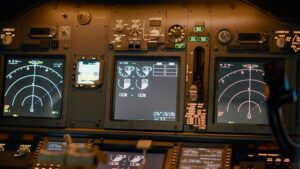Flight Data Recorders (FDRs) are the quiet guardians of the skies, capturing every flight’s complex dance with great care.
These instruments, which are a part of every aircraft, record a wealth of information on anything from engine performance and control inputs to altitude and airspeed. They are essential resources for maintenance analysis, accident investigation, and improving aviation safety in general.
The ARINC 453 standard, a fundamental foundation that determines how data is recorded and transferred within these vital flight recording systems, is at the heart of FDR technology.
We set out on a journey to investigate the symbiotic relationship between ARINC 453 and FDRs in this blog, revealing how this standard improves the functioning and performance of these essential aviation devices.
Join us as we delve into the intricacies of ARINC 453, unravel its technical intricacies, and uncover how its implementation translates into tangible enhancements in FDR performance.
From improved data accuracy to enhanced recording capabilities, we’ll dissect the key features and benefits of ARINC 453 integration, shedding light on its profound impact on aviation safety and operational efficiency.
Understanding Flight Data Recorders (FDRs)

Flight Data Recorders (FDRs), often referred to as “black boxes” despite their distinct orange color, serve as silent witnesses to the events unfolding in the skies.
These rugged devices, built to withstand the most extreme conditions, are installed on virtually every commercial aircraft, capturing a wealth of critical flight data during every moment of a journey.
Importance in Aviation Safety:
FDRs play a pivotal role in aviation safety, serving as invaluable tools for accident investigation, performance monitoring, and maintenance analysis.
They provide investigators with a comprehensive snapshot of an aircraft’s behavior leading up to an incident or accident, offering vital insights into the sequence of events and contributing factors.
Key Components and Functionalities:
A typical FDR comprises several essential components, each playing a crucial role in the data recording process. These components include:
- Cockpit Voice Recorder (CVR): While distinct from the FDR, the CVR is often housed within the same enclosure. It records audio from the cockpit, including communications between the flight crew and air traffic control, as well as ambient sounds and cockpit noises.
- Flight Data Acquisition Unit (FDAU): This unit interfaces with various aircraft systems, collecting data from sensors and avionics equipment. It captures a wide range of parameters, including altitude, airspeed, heading, engine performance, control inputs, and more.
- Crash-Protected Memory Module: The recorded data is stored in a crash-protected memory module, designed to withstand high-impact forces and extreme temperatures. This module ensures that crucial flight data remains intact and retrievable even in the event of a catastrophic incident.
Regulations and Standards:
FDRs are subject to stringent regulations and standards set forth by aviation authorities worldwide.
For example, the International Civil Aviation Organization (ICAO) mandates that all commercial aircraft must be equipped with FDRs meeting specified requirements, including durability, data recording parameters, and crash survivability.
Continuous Monitoring and Improvement:
Advancements in technology have led to continuous improvements in FDR capabilities. Modern FDRs boast enhanced data recording rates, expanded storage capacity, and increased functionality, enabling them to capture a more comprehensive picture of flight operations.
Enhancements Offered by ARINC 453
In the realm of aviation, precision, and accuracy are paramount, especially when it comes to recording and analyzing flight data. ARINC 453 stands as a beacon of excellence in this regard, offering a suite of enhancements that elevate the performance and functionality of Flight Data Recorders (FDRs) to new heights.
Improved Data Recording Capabilities:
The capacity of ARINC 453 to enable increased data recording speeds and more bandwidth is one of its main benefits.
In contrast to its predecessors, which might not have had the same capacity to collect data at optimal rates, ARINC 453 gives flight directors the ability to record a more precise and comprehensive picture of flight operations.
This enhanced capacity to record data is especially important in situations where there are quick changes to the flight parameters, including during takeoff, landing, or emergencies while in flight.
ARINC 453 guarantees that no important detail is missed by collecting data at increased rates, giving investigators a comprehensive dataset to review after an incident or disaster.
Furthermore, ARINC 453 enhances the accuracy and precision of recorded data, minimizing discrepancies and errors that may arise during the recording process.
This precision is essential for maintaining data integrity and ensuring that the information retrieved from FDRs is reliable and actionable.
Increased Flexibility in Data Types and Formats:
The versatility of ARINC 453 in handling a large number of data kinds and formats is another important benefit.
In contrast to earlier standards that could have had restrictions on the kinds of data they could capture or send, ARINC 453 provides more flexibility by supporting a wide range of parameters and formats that are customized to meet the unique requirements of particular aircraft and operators.
Because of this adaptability, FDRs that are outfitted with ARINC 453 can record more specialized data pertinent to particular aircraft systems or operational requirements in addition to standard flight metrics like altitude, airspeed, and engine performance.
ARINC 453 guarantees that FDRs can adjust to the changing needs of contemporary aviation, whether it is by measuring fuel use, recording cabin environmental conditions, or keeping an eye on the functioning of avionics equipment.
Additionally, operators can build their own data structures and encoding schemes to meet their specific needs thanks to ARINC 453’s support for customized data formats.
By allowing for customization, operators can ensure optimal efficiency and usefulness by customizing FDR data recording to meet their unique operational requirements.
Integration of ARINC 453 in FDR Systems
The seamless integration of ARINC 453 into Flight Data Recorder (FDR) systems is a critical step toward harnessing its full potential in enhancing aviation safety and operational efficiency.
This process involves not only the physical incorporation of ARINC 453-compliant hardware but also the integration of software, protocols, and data management systems to ensure optimal performance and compatibility.

Implementation Challenges and Considerations:
Integrating ARINC 453 into FDR systems presents several challenges and considerations that must be carefully addressed:
Hardware Compatibility: FDR systems must be equipped with hardware components that are capable of interfacing with ARINC 453 protocols and data formats. This may require upgrades or modifications to existing systems to ensure compatibility.
Software Development: Software plays a crucial role in processing, storing, and managing data recorded by ARINC 453 standards. Developing software that can effectively handle the complexities of ARINC 453 data is essential for seamless integration.
Data Synchronization: FDR systems often comprise multiple sensors and data sources, each generating streams of data that must be synchronized and correlated to provide a comprehensive picture of flight operations. Integrating ARINC 453 data into this ecosystem requires careful synchronization to ensure accuracy and consistency.
Regulatory Compliance: FDR systems must adhere to regulatory requirements set forth by aviation authorities, including standards governing data recording, storage, and retrieval. Ensuring compliance with these regulations is paramount during the integration process.
Despite these challenges, the integration of ARINC 453 into FDR systems offers significant benefits in terms of enhanced data recording capabilities, improved accuracy, and greater flexibility.
By addressing these challenges through careful planning, collaboration, and technical expertise, operators can unlock the full potential of ARINC 453 to enhance flight safety and operational efficiency.
Compatibility with Existing Systems:
One of the key considerations in integrating ARINC 453 into FDR systems is ensuring compatibility with existing hardware and infrastructure. Many aircraft may already be equipped with FDR systems that comply with earlier ARINC standards or proprietary protocols.
To facilitate seamless integration, manufacturers may offer upgrade kits or retrofit solutions designed to bring existing FDR systems up to ARINC 453 compliance.
These solutions may include hardware upgrades, software updates, and calibration adjustments to ensure compatibility and interoperability with ARINC 453-compliant systems.
Additionally, compatibility testing and validation procedures are essential to verify that integrated FDR systems operate reliably and effectively in real-world scenarios. This may involve simulated flight testing, ground-based verification, and certification processes to ensure compliance with regulatory requirements and industry standards.
Benefits of ARINC 453 in FDR Performance
The adoption of ARINC 453 brings forth a multitude of benefits that profoundly enhance the performance and functionality of Flight Data Recorders (FDRs).
From improved data accuracy to enhanced operational efficiency, the integration of ARINC 453 standards elevates FDRs to new levels of reliability and effectiveness, thereby contributing to enhanced aviation safety and operational excellence.
Enhanced Data Accuracy and Precision:
ARINC 453 facilitates the recording of flight data with unparalleled accuracy and precision. By adhering to standardized protocols and data formats, ARINC 453-compliant FDRs ensure consistency and reliability in the recording of critical flight parameters.
This precision is essential for providing investigators with a detailed and accurate portrayal of flight operations, enabling comprehensive analysis and reconstruction of events leading up to incidents or accidents.
Moreover, ARINC 453’s support for higher data recording rates and increased bandwidth allows FDRs to capture a more granular and detailed picture of flight operations.
This enhanced data granularity enables operators to identify subtle anomalies and trends that may have previously gone unnoticed, facilitating proactive maintenance and performance optimization.
Greater Flexibility and Customization:
ARINC 453 offers greater flexibility and customization options, allowing operators to tailor FDR recording parameters to suit their specific operational requirements.
This customization capability enables operators to prioritize the recording of critical flight parameters while optimizing storage space and bandwidth utilization.
Furthermore, ARINC 453 supports the recording of a wide range of data types and formats, including traditional flight parameters, avionics data, and specialized sensor outputs.
This versatility allows FDRs to capture a comprehensive dataset that reflects the unique characteristics and operational context of each flight, providing valuable insights into aircraft performance and system health.
Improved Post-Incident Analysis and Investigation:
The enhanced data accuracy and granularity offered by ARINC 453-compliant FDRs significantly streamline post-incident analysis and investigation processes.
Investigators can rely on the detailed and comprehensive data captured by ARINC 453 FDRs to reconstruct the sequence of events leading up to an incident or accident with unprecedented accuracy and detail.
Moreover, ARINC 453’s standardized data formats facilitate seamless data exchange and interoperability between different FDR systems and analysis tools.
This interoperability ensures that investigators can efficiently access and analyze FDR data using a variety of software applications and platforms, enhancing collaboration and information sharing within the aviation industry.
Conclusion
ARINC 453’s integration into Flight Data Recorder (FDR) systems is a pivotal advancement in aviation safety. By enhancing data accuracy, precision, and flexibility, ARINC 453-compliant FDRs empower operators with vital insights for proactive maintenance and comprehensive post-incident analysis.
This standard symbolizes a commitment to excellence, driving continuous improvement in aviation safety and performance. Embracing ARINC 453 reflects a dedication to safety and innovation, ensuring a safer and more efficient future for aviation.






